Raising Water Consciousness through
World’s Biggest Photo Exhibition and
Largest collection of Photo Stories on Water
Photo Stories | Water and Culture
Water and Religion: Contemporary Challenges Impacting their Connection
Nandita Singh and Om Prakash Singh
16 September, 2017
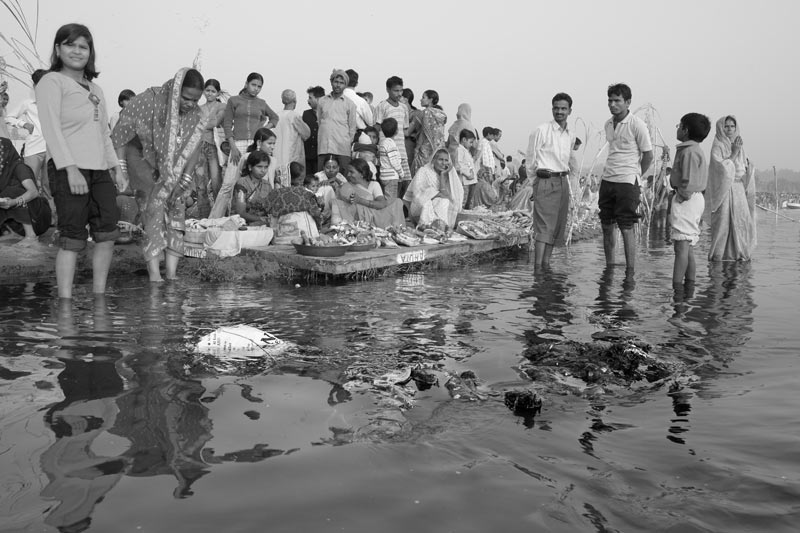
Strong connections exist between water and religion which in turn hold great relevance for society. These intricate relationships, existing as the "water-religion-society continuum", have been described in the previous story dated August 16, 2017. Despite its functionality and importance, in contemporary India this continuum is facing numerous challenges. In the context of Hinduism, it can be seen that sacred values ascribed to water and water sources, and the perception of its presence on Earth as a divine gift are either being questioned or simply ignored. Similarly, deification of water and water sources, and the attribute of purity attached to sacred water bodies, is being upheld by many only at a symbolic level, divorced from the real state of water bodies. As a result, the collective obligation placed upon society to sustain water and uphold its quality in the pristine state has come to be eroded. The repercussions of these challenges can be seen at two levels. First, the observance of religious rituals and practices based on clean and pure water in general and specific water bodies in particular itself gets challenged. Second, since the religious beliefs, values and practices are a means to promote the sustainability of water resources, access to adequate and good quality water for various secular uses like drinking and irrigation gets affected. The society can be seen as split into three groups with regard to attitudes and behavior regarding water and religion. These consist of 'full-believers' and 'non-believers' at the two extremes with a group of 'half-believers' in between. The 'full-believers' adhere to the religious values, beliefs and practices connected with water in totality while the 'non-believers' reject or dismiss these as non-scientific and superstition. The former strive to uphold the sanctity of the sacred water sources and take utmost care that they do not cause any degradation of water resources while for the latter water is just a resource or commodity which should be used maximally for human benefit. The 'half-believers' are a varied group who basically have faith in the religious beliefs and values concerning water but fail to see these as placed within a larger holistic context. As a result, they continue the religious practices connected with water but either redefine them in new individualized forms or else knowingly or unknowingly perform actions that degrade water resources, driven by ignorance, ease, convenience or greed. The 'non-believers' and 'half-believers' are together responsible for the challenges confronting the connections between water and religion. This photo story attempts to portray the different kinds of challenges confronting the "water-religion-society continuum" in the context of Hinduism. The title photo depicts devotees struggling to perform Chhath Puja in the scanty waters of degraded Yamuna river in North-East district, National Capital Territory of Delhi. In order to fulfil the ritual requirements and to derive the scientific benefits, the water should be clean and the level be high upto the waist. However, here the water level is too low, and the water is dirty and impure, which makes it difficult for the devotees to uphold the religious sanctity of the festival.
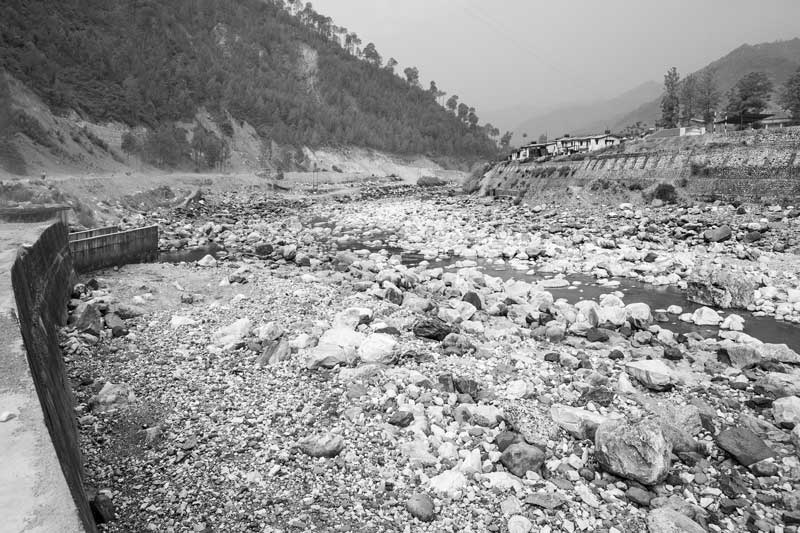
Dried bed of river Bhagirathi at Uttarkashi, Uttarakhand
Ganga is the most sacred river of India, originating as Bhagirathi in the Gangotri glacier in Uttarakhand. According to Hindu mythology, Ganga descended on Earth at the request of King Bhagirath for salvation of his 60,000 ancestors, hence the name Bhagirathi. Bhagirath performed long penance at Gangotri for receiving Ganga's blessings who first descended from heaven into the matted hair of Lord Shiva in the Himalayas, and then came further down to flow on Earth. She is regarded as a mother whose touch is purifying and healing and it is believed that wherever she flows, pollution is cleaned away and the nature and people are nurtured. However, in recent times, this symbolic value of Ganga has come to be eroded and the sacred river has started being looked down upon with greed as a mere resource to be exploited for maximizing human gains. The sacred water of Bhagirathi is being diverted for hydropower generation and urban water supply for distant locations in Delhi and Uttar Pradesh. For this purpose, the original river bed is dried out at many places and the water instead diverted through tunnels. In all, about 114 km of the river stretch is being dried out and its water forced to flow through the alternate route of tunnels extending over a total of 52 km. Consequently, the communities in the Himalayas that were nurtured by the river are being deprived of their access to the river and the bounties it brought. Manipulation of the natural course of the sacred river in this manner impinges upon the religious values ascribed to it. It is believed that Ganga remains holy only when its flow is 'aviral'—i.e., constant and uninterrupted. Drying of the river bed and tunneling of the water through alternate routes thus deprives the river of its holiness and the divine life force, undermining many cultural and religious practices.
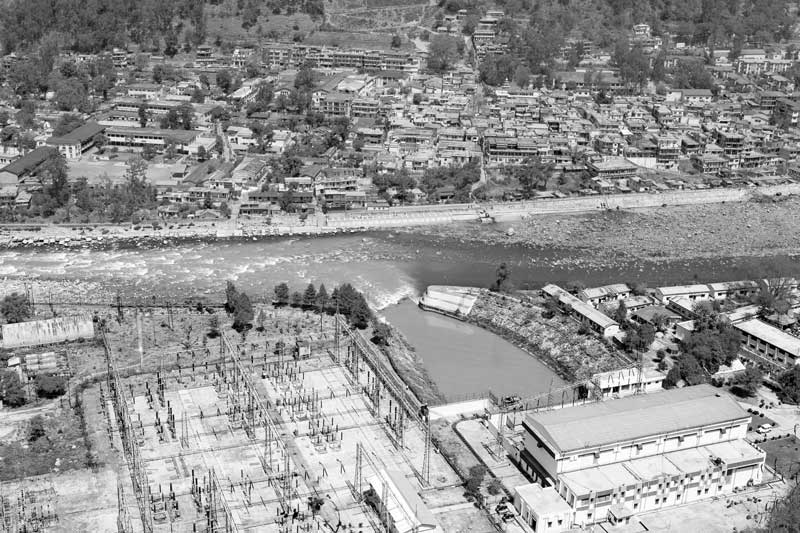
River Bhagirathi emerging from a tunnel at Tiloth Power House in Uttarkashi, Uttarakhand
Uttarkashi literally means "the Varanasi of the North" and is the abode of Lord Shiva. He is worshipped at the Vishwanath Temple located near the banks of Bhagirathi. Considering this religious importance of the town, lip-service has been paid for upholding the river's sanctity by leaving it largely undisturbed in its natural course within the major part of the town. The above photo shows release of Bhagirathi from a tunnel after hydropower generation at the 90 megawatts Tiloth Power House just upstream of the town. Water for the powerhouse is diverted through a tunnel from Maneri Dam on Bhagirathi upstream. After the town the river is again tunneled at Bhali (Joshiyara) Dam. As many as 14 hydro power projects are planned/executed on this river in Uttarkashi district, with an installed total hydropower capacity of over 3,472 MW. Not only is religious sanctity of Bhagirathi in particular and Ganga in general shaken by these constructions and diversions, but local ecologies and livelihoods are seriously affected. Villages in the basin have started facing situations of drought because deforestation, changes in topography and altered land use in the mountains has affected rainfall adversely. Reduced rainfall causes poor agricultural yield. The natural drinking water sources in the villages, namely, Gadera and Chahal are getting dried up, causing drinking water shortage and reduced agriculture causes food scarcity.
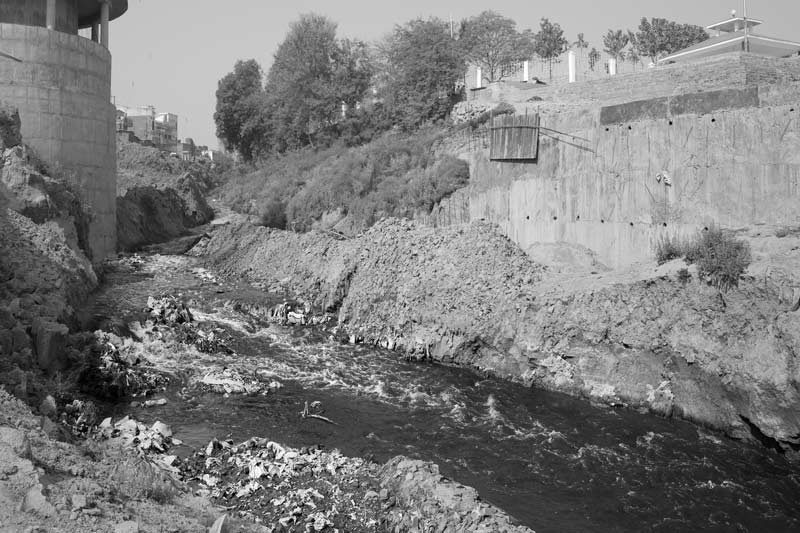
River Asi carrying the city's untreated wastewater in Varanasi, Uttar Pradesh
Varanasi –the spiritual capital of India - is the holiest of the seven sacred cities (Sapta Puri) in Hinduism, primarily lying between the confluences of river Ganga with rivers Asi in the south and Varuna in the north. It is the abode of Lord Shiva at Kashi Vishwanath Temple, which is one of the 12 Jyotirlinga Shiva temples in the country. A visit to the temple together with a holy bath in river Ganga is believed to lead the way towards salvation (moksha). According to legend, Goddess Durga had thrown her sword in Varanasi after slaying the demons Shumbha–Nishumbha. The place where the sword fell resulted in a big stream known as the Asi. Near the confluence of the rivers Ganga and Asi, Asi Ghat is located, references to which exist in a number of religious scriptures. This ghat is widely visited by pilgrims and locals alike. Despite the religious significance of Asi river and the Asi Ghat, today the river is struggling for its existence. Its catchment is heavily encroached with residential buildings constructed along the banks, cutting down the natural drainage basin and solid waste is dumped on both sides of the river which enters the river in the monsoon. The river has negligible natural flow today, but swells with ever increasing volumes of untreated municipal sewage and oily and greasy substances from nearby industries, converting the river into a big drain.
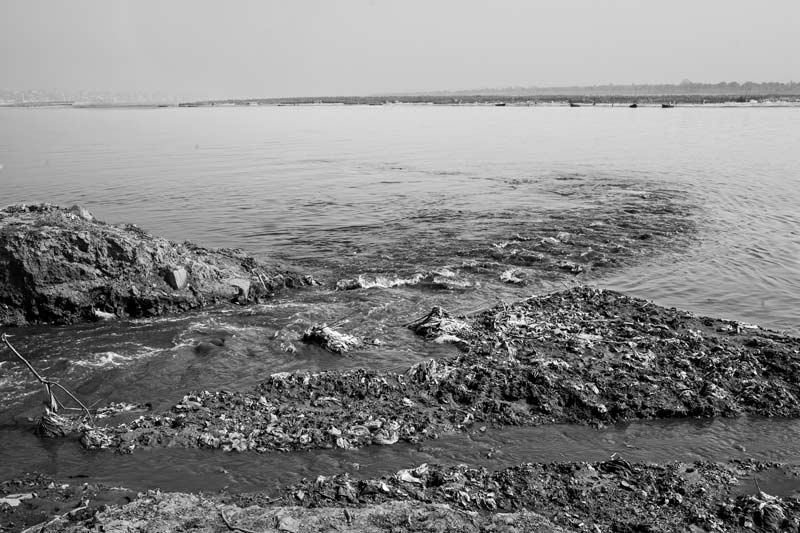
River Asi draining untreated wastewater into river Ganga in Varanasi, Uttar Pradesh
At the confluence of river Asi with Ganga, it is easy to differentiate the two streams by their color and constitution since the color of polluted Asi is distinctly black. The BOD (biochemical oxygen demand) in Asi is around 4 mg/l and the fecal coliform count (FCC)/100 ml is around 60,000. According to Indian standards, for water to be safe for even bathing, BOD should be less than 3 mg/l whereas the FCC should be less than 500/100ml, and for drinking the FCC should be zero. Such a degradation of water quality in Asi is caused by many non-believers and half-believers who, driven by greed and apathy, resort to releasing sewage and industrial effluents directly into the river without any treatment. This state of affairs raises serious doubt over the quality of Ganga water into which Asi and many other polluted rivers drain. In fact, according to recent government figures, 4,256 MLD of untreated sewage mixed with industrial effluents is released into river Ganga from its point of origin up to Varanasi. The existing sewage treatment capacity in the city is only one-third, and residues of pesticides and insecticides from farms are washed into the river along the entire course. The river water at the end of the city is grey and stinks, with methane bubbles coming to the surface. This poses grave challenge to the purity and sanctity of this holy river.
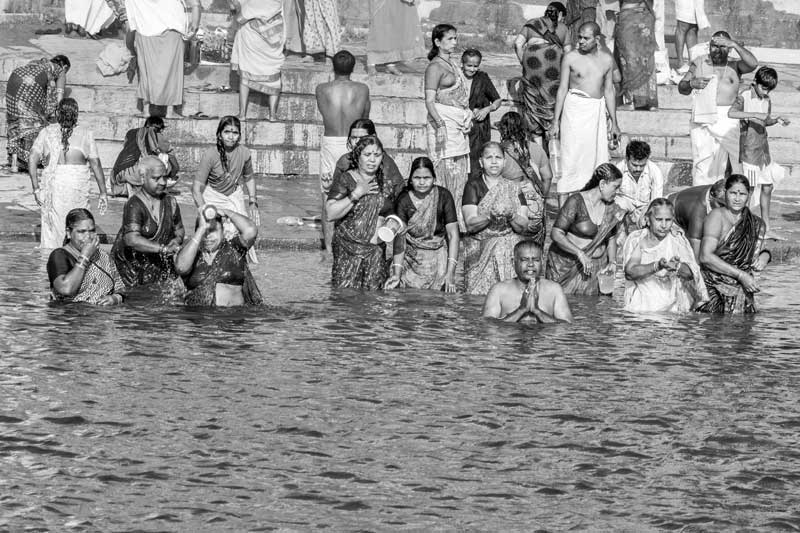
Devotees taking holy bath at a Ghat on the banks of river Ganga in Varanasi, Uttar Pradesh
There are about 88 Ghats on the banks of river Ganga in Varanasi, which are riverfront steps leading to the banks. Here pilgrims visiting the holy city from all corners of the country arrive in search of emancipation and peace through the holy bath and performance of different rituals. However, due to the high level of pollution in the river as described above, their religious sentiments are deeply hurt, and some of them may even be discouraged from performing their religious duties. Despite their religious sentiments, many of these pilgrims may make a smaller contribution to the river's pollution knowingly or unknowingly by releasing offerings of flowers, plastic bags and other substances used in rituals as also physical remains from the cremation Ghats directly into the river.
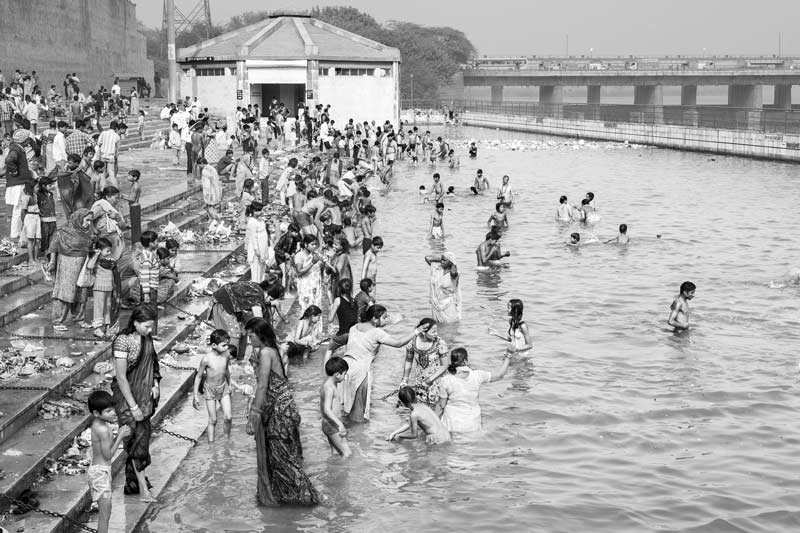
Devotees undertaking holy bath on the occasion of Kartik Purnima in an artificial water pool along river Yamuna in North district, National Capital Territory of Delhi
Yamuna is one of the seven sacred rivers in India which is impounded before it enters Delhi and the water is diverted for municipal water supply, leaving a small trickle in the river bed. Instead the river is used as a drain with residential colonies and industries dumping untreated wastewater and even solid garbage into the river bed. At the time of Chhath Puja and other religious occasions connected closely with water, the river water is provisionally diverted back or alternate arrangements are made. The river flow in the former case is generally so scant that it is unable to revive the purity of the water stream and clean the waste dumped in it, as depicted in the title photo. Among alternate arrangements is the depiction in the present photo where devotees are having holy bath on Kartik Purnima in a special pool created on the banks of Yamuna which is filled with either water from the river or groundwater. The ritual bath on this occasion is supposed to be undertaken in one of the sacred rivers or other traditionally sacred water bodies. In such cases as this one, though the bath is facilitated, the religious spirit underlying it is dampened.
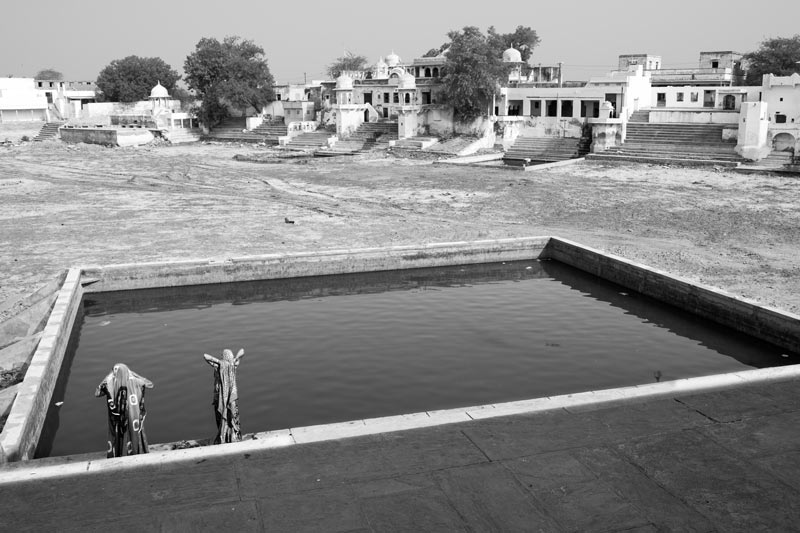
Holy bath at a constructed tank inside the sacred Devayani Kund in Sambhar Lake town, district Jaipur, Rajasthan
Devayani Kund is a sacred tank having sweet water in the salt-ridden Sambhar Lake region of Rajasthan. It is dedicated to Devayani, the daughter of Shukracharya, who was the priest of Asuras (the demons). It is believed that Aswathama, a hero of the epic Mahabharat, had come for penance to this sacred tank. With a number of centuries old temples dedicated to various gods located around it, the tank is an important Hindu pilgrimage, regarded as the "grandmother of all pilgrimages". Thousands of devotees take holy bath here every year on the occasion of Baisakhi Purnima (in April) when Aswathama is still believed to visit. Other important occasions are the month of Kartik (October-November) and 5 days every month from Ekadashi to Purnima dates. The apparent religious value attached to Devayani is actually a means to uphold its secular importance as the single source of sweet water in a vast salty stretch around the saline Sambhar Lake. The sweet water available in Devayani is a source of recharge of groundwater in the entire area, enabling surrounding communities to procure sweet drinking water from their wells round the year. However, during the past 3 decades, Devayani Kund and its catchment have been increasingly subject to mis-management, leading to its drying up shortly after monsoon. Since this can lead to disruption of its religious function, the government adopted the lip-service of constructing a smaller cemented tank on one part of the large tank which is artificially filled with groundwater every two weeks. While this allows pilgrims and local devotees to undertake holy bath, the more serious consequence for the communities around which entails reduced groundwater recharge and the resultant drying up and salinity in wells has remained unaddressed. People remain dependent upon piped water supply from Bisalpur Dam which is however irregular.
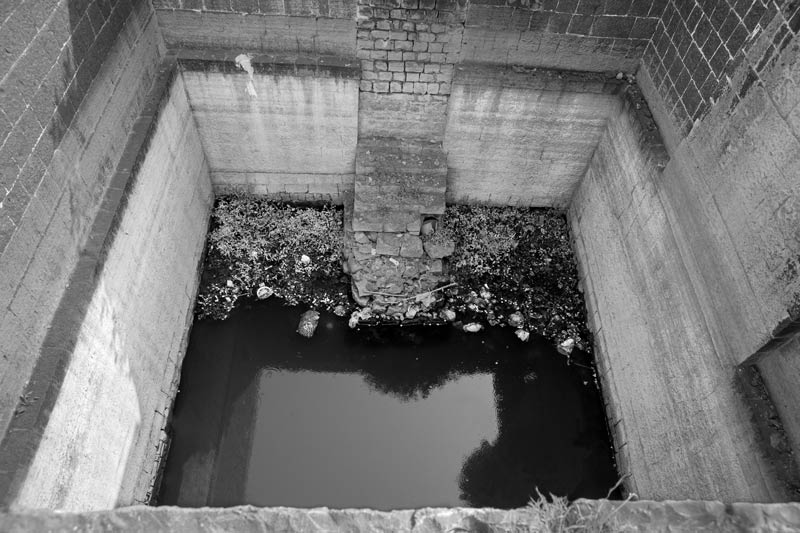
Well – a water source always considered sacred – lying in a state of neglect and disuse in district Ahmednagar, Maharashtra
Wells have been always considered as sacred water sources, with special efforts traditionally made to uphold cleanliness of the source and purity of the water. In some cases, temples had sacred wells or else, temples used to be often constructed near wells. Often religious rituals were performed near them and strong social rules operated to ensure that pollution of the source be prevented. While the ostensive purpose of these social rules was to safeguard the ritual sanctity of the well and thereby enable religious practices, the ultimate purpose was to ensure supply of clean and pure drinking water for the community. However, after the coming of new water supply alternatives such as the handpump and piped water supply, the ritual value of the well is being forgotten and the sacred values attached to it are dismissed as old sayings or even superstition. The associated social rules are becoming obsolete because cleanliness and purity of the well water is no longer a requirement, and even garbage and waste is disposed into unused wells. This has led to a two-pronged repercussion. On the one hand, more ostensibly, the religious beliefs and practices of the 'full believers' gets affected, but a much deeper impact is evident in areas where the new water sources have failed to sustainably deliver pure drinking water and local communities are having a hard time finding good alternatives. The above photo depicts such a situation in a village in semi-arid Maharashtra where this well used to be the only source supplying sweet drinking water as well as water for religious uses, but after the coming of alternate drinking water sources, it came to be neglected. However, now the villagers face problem because the piped water supply is irregular while the handpumps are either dry or provide saline water.
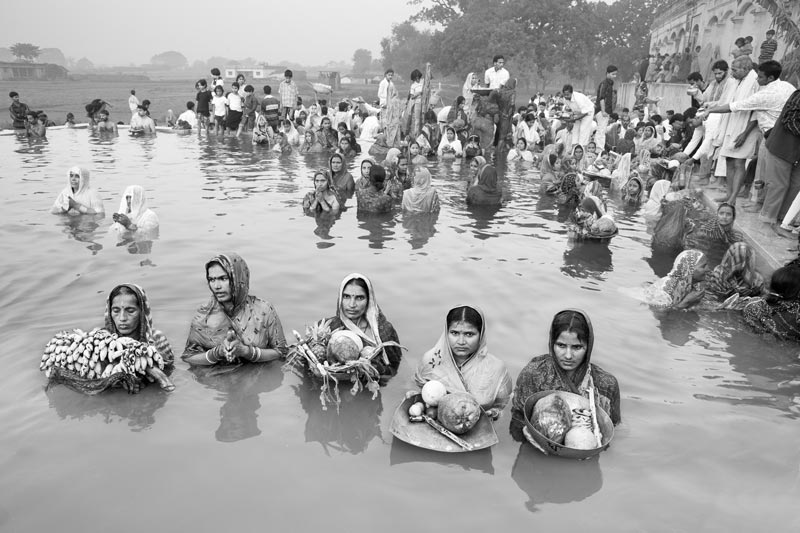
Performing Chhath Puja in an artificially constructed tank in a village in Bhojpur district, Bihar
Chhath Puja is an important ancient Hindu Vedic religious festival where water plays an important role. Celebrated in the Hindu months of Kartik (October-November) and Chaitra (March-April), the religious rituals are traditionally performed on the bank of a river, pond or other source of water, where holy bath is taken, and offerings of sacred water and food (prasad) are made to the setting and rising Sun god along with his wives goddesses Pratyusha and Usha respectively, and to 'Chhathi Maiya'. The latter is believed to be a form of Devi Parvati (mother goddess) and Lord Surya's sister, or else as daughter of Lord Brahma. This process is called offering of arghya and is undertaken while standing in water, preferably with half the body immersed. Besides devotees also meditate and pray for long periods of time standing in water. In present times, devotees have come to face serious challenges in performing the Chhath rituals due to lack of water availability in rivers and ponds or lack of cleanliness and purity of the water. This has led to replacement of the degraded sacred water sources with alternate artificially constructed sources such as the one depicted in the above photo.
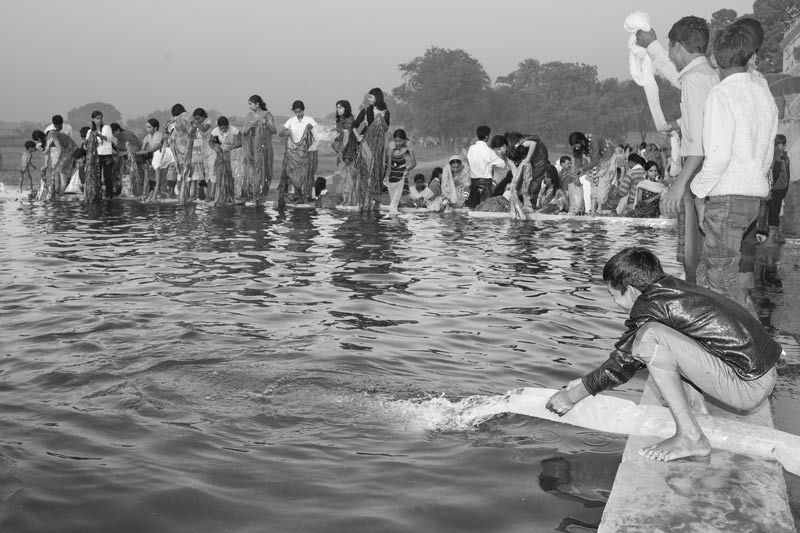
The above depicted constructed tank being filled with groundwater in a village in Bhojpur district, Bihar
This photo depicts the situation in a village where a communally owned sacred pond near the village temple complex where devotees used to perform holy bath and other water-related rituals during Chhath puja and other religious occasions has fallen prey to mis-management and neglect. The village wastewater drains into the pond, degrading the water quality, thus rendering it unusable for religious purposes. Further, driven by greed of some of the politically and economically dominant villagers, the sacred pond has been converted into a fish farming tank. As a result, for fulfilling the religious water needs, an artificial cemented tank has been constructed by one of the villagers who is individually responsible for its maintenance and upkeep. The tank is filled up at the time of religious festivals with groundwater. In addition, in many other instances of Chhath celebration, it is known that where either the water source is degraded or on the basis of social, political or economic status, devotees consider it to be inappropriate to attend rituals in public at sacred water sources, the rituals are performed in tanks constructed within private premises. Through public and private alternatives somehow one's religious activities connected with water undoubtedly gets fulfilled, and this trend is increasing. However, since the purpose of beliefs, values and practices connected with water was not only to fulfil religious requirements but also to ensure upkeep and maintenance of the water sources in general, the increasing trend of creating different alternatives to fulfil the religious functions is resulting in a situation where the traditional bigger water sources are getting increasingly ignored, challenged and decayed. Further, adoption of the public and private alternatives dampens the spirit of community management of sacred water bodies which in turn furthers the process of degradation of the community's water resources.
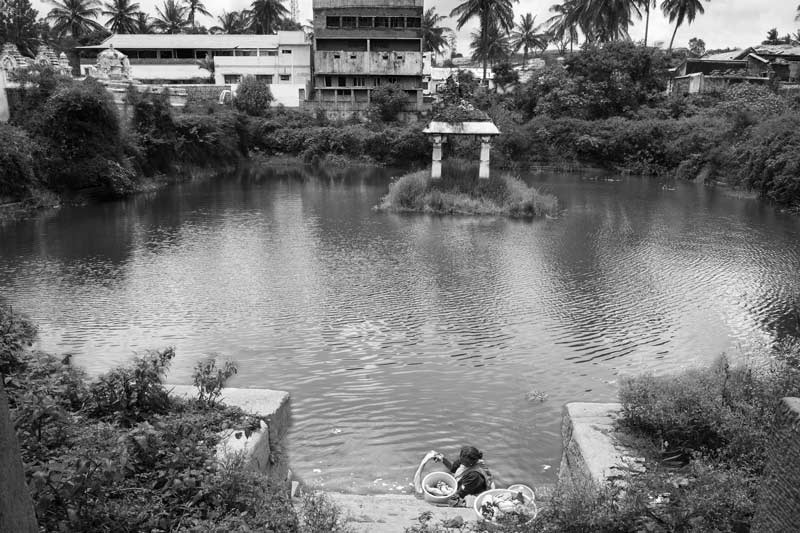
A dead sacred tank named Thirunarayanaswami Kulam in Melukote - a town in Mandya district, Karnataka
Melukote is a town of sacred tanks and a center of Sanskrit and Vedantic learning, situated at a height of approx. 1100 meters above sea level. Historically, it did not have any other source of water except rain. As a result, the rulers of Melukote relied on rainwater harvesting and built 108 tanks and ponds systematically constructed at different levels and at different locations so as to collect enough rainwater to provide for temple rituals, ablutions by devotees and general public use, even retaining water during severe drought. However, in present times, not all Melukote tanks and ponds are well maintained. Even sacred tanks that served ritual functions as well as provided drinking water to local communities have come to be neglected, particularly after coming of piped water supply in the town. The photo depicts a sacred tank called Thiru Narayanaswamy Kulam, associated with the Sri Cheluva Narayana Swamy Temple (also called Thiru Narayana Swamy temple) which lies mis-managed and neglected in present times. It has been encroached by local residents mainly through construction of houses and other urban infrastructure. Once a drinking water source for the residents, today the tank is used for washing clothes. Even garbage is dumped in the vicinity and the inlet and outlet are blocked. All this causes pollution of the tank and reduces the water inflow. As a result, the ritual water needs of devotees visiting the temple are affected, and they have to manage with alternate water sources installed near the temple.
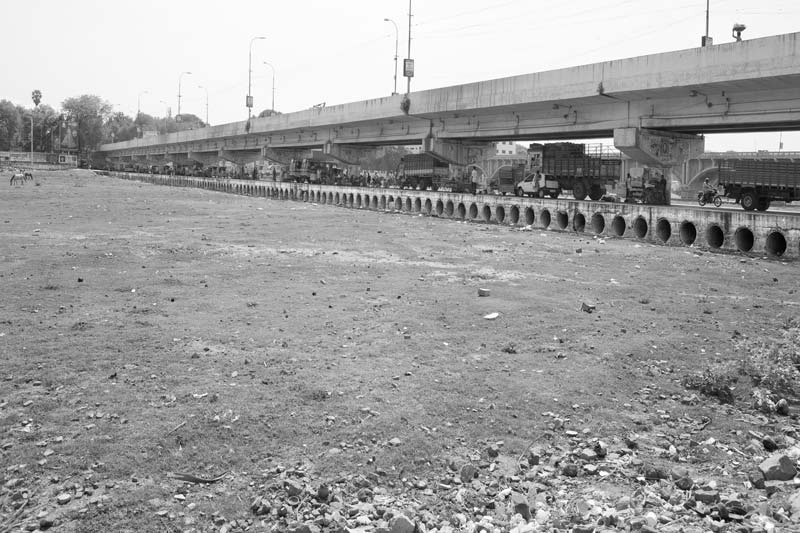
A view of the dried-up bed of river Vaigai during the monsoon month of Aadi in Madurai, Tamil Nadu
Vaigai is a sacred river believed to be equivalent to Ganga since it flows out of the matted hair of Lord Shiva who married goddess Meenakshi of Madurai. This great temple city has developed and thrived on the fertile plains of Vaigai, being one of the oldest continuously inhabited religious centres of the world. A number of religious festivals are connected to the sacred waters of this river. Over 236,000 acres of land depends on it for irrigation and over 2 million people are dependent for drinking water. According to older local residents of the city, until about 15 years ago Vaigai used to be a beautiful river that 'flowed to its brim' most of the year round, with little or no pollution but now the river bed remains almost dry throughout the year, even during the monsoon month of Aadi. The little water that it brings from the Western Ghats is stored in the Vaigai Dam upstream and many tanks in the city which used to be fed by Vaigai have disappeared. Many non-believers and half-believers, driven by motives of greed and convenience have caused large-scale deforestation and encroachment in the catchment. Moreover, discharge of municipal sewage and industrial effluent has degraded the water quality. All this has brought this sacred river to a deplorable state where today it can neither support religion nor nurture the people and their environment. However, despite the drying up of the river, it continues to be highly revered in the region.
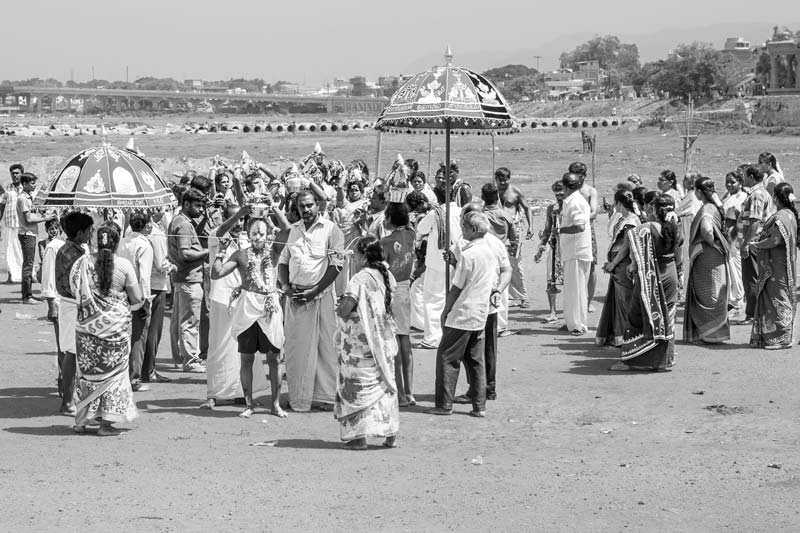
Devotees gathered for religious celebrations during Tamil month Aadi at the dried-up Vaiagi river bed in Madurai, Tamil Nadu
Aadi (July-August) signifies the Tamil month when due to onset of monsoon, all water bodies are supposed to be filled to their brims and a number of festivals are celebrated. Drying up of the river makes it difficult for devotees to celebrate the festivals of this month as well as others. Important festivals of Aadi are Aadi Mulaikottu, Aadi Perukku and Aadi Amavasai. Another important festival is Chithirai celebrated during the Chithirai month (April-May). Despite the drying up of river Vaigai, devotees continue to assemble in large numbers on the river bed, in an attempt to celebrate the festivals connected to the river and to fulfil the religious obligations. Aadi Perukku is a festival where devotees offer prayers to keep the river and connected tanks perennially filled so that they will have enough water for agriculture and other uses throughout the year. However, due to lack of water in the river, this year many people had to travel outside Madurai to other sites in the state in order to undertake the rituals. A wider result of drying up of Vaigai is seen in the serious water scarcity in the city which even affects celebration of festivals that are not directly celebrated on the river bank. An example is Aadi Amavasai when water is offered to ancestors (called tarpana) after shaving of heads and ritual bathing. This year, at a number of temples in the area devotees had to manage these rituals with bottled water since there was little water available at the temples. The Chithirai festival when Lord Kallazhagar (Vishnu) undertakes journey from Alagarkoil to Vaigai river, entering it to bless his sister goddess Meenakshi Amman of Madurai on the occasion of her marriage with Lord Shiva, is being celebrated on the dry bed of Vaigai for the last two years. This is an event which continues to draw hundreds and thousands of devotees on the banks of the river even now.
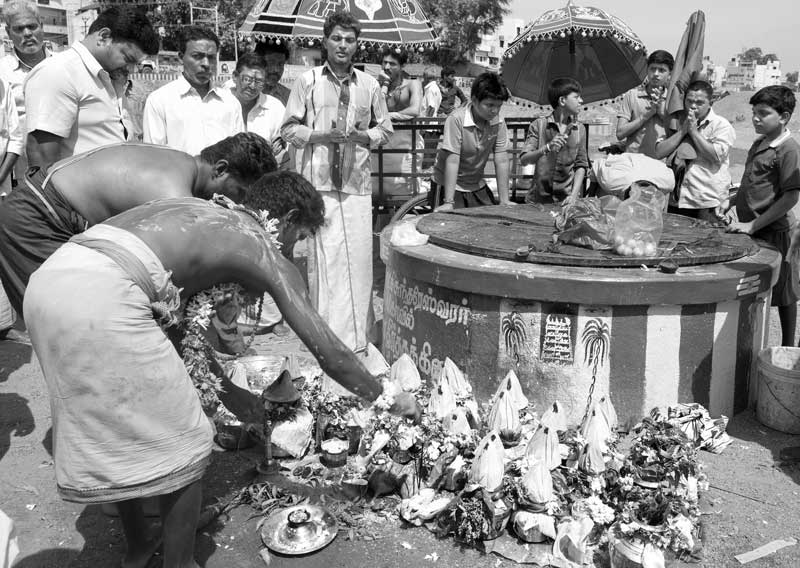
Rituals being performed during Aadi month near a temple well in the dried-up Vaigai river bed in Madurai, Tamil Nadu
In some instances as shown in the photo above, alternate arrangements have been made for procuring sacred water of Vaigai and celebration of religious festivals in the dry bed of Vaigai. Here, instead of bathing in the river and using the river water for purposes of worship, water is taken from wells dug in the river bed and used for taking holy bath, and also for performing worship. In the above photo, worship is being performed next to a sacred well belonging to the famous Meenakshi Sundereshwarar Temple, the water from which is meant for abhishek (anointing) of the deities. In the light of persistent difficulties faced in performing the rituals connected to river Vaigai and its water, there exists risk that many devotees may lose interest, thus dampening the religious spirit, in turn further spiraling the destruction of the river and the ecosystem it has supported through generations. Further, as noted, a more general repercussion is the unprecedented lowering of groundwater levels due to highly reduced recharge from the river and its connected tanks. The story of Vaigai is not unique in the state, nor in the country. In many cities and villages in areas with high dependence on rainfall and the resultant runoff, scarcity of water for religious and secular purposes is becoming a common ailment.
From this photo story it clearly emerges that the deep and holistic relationship between water and religion in India is facing important challenges in contemporary times in the context of Hinduism, in turn impacting upon society in many direct and indirect ways. One of the most evident challenges emerges from the condition of many sacred water bodies turning critical – either the water is insufficient or it is polluted. In such a situation devotees - who may belong to the category of 'full believers' or 'half-believers' - face problems in performing the rituals and religious activities connected with water. In such a situation, while the former still adhere to original practices although their religious sentiments may be hurt, the latter instead resort to finding individualized alternate solutions furthering their ease and convenience instead of initiating collective action to address the challenge. Such dilution of collective responsibilities towards upkeep and maintenance of sacred water bodies thus in itself feeds into the loop as a challenge. A third challenge comes from 'non-believers' and those 'half-believers' who fail to connect their water-related religious beliefs, values and practices to their secular responsibilities towards water. The 'non-believers' completely reject the religious beliefs, values and practices concerning water and instead consider water as a mere resource for fulfiling human needs, or as a commodity often for fulfilling human greed. It is important to understand that these attitudes and actions are not restricted to sacred water sources and religious aspects alone. Many sacred water sources like ponds and wells have also served as drinking water sources while sacred rivers like Ganga, Yamuna or Vaigai, have been cradles of civilization. Indifference towards the connections between water and religion and its replacement by pure exploitative intentions have played havoc with the water resources, bringing about their degradation in terms of quality or quantity. This ultimately thwarts the practice of religion and leads to unsustainability of water and environment. In such a context, even the group of 'full believers' may risk the loss of faith in the water-religion connections and ultimately transform into 'half-believers'. The connections between water and religion help inculcate discipline through fear or reverence that helps management and upkeep of water resources by society. Challenges to the water-religion connections lead to disruption of these delicate bonds with society. At an individual level, this thwarts the cultural rights of the women and men who are 'believers', hurting their religious sentiments and affecting their religious practices. It also hinders the development of a sustainable society that can thrive in balance with nature, as exemplified repeatedly in this story. These cases illustrate beyond doubt that neglect of water as a sacred resource and apathy towards the care and upkeep of sacred water sources is not a problem for religion alone but has wider ramifications for water sustainability in general, affecting availability of adequate clean water for drinking, agricultural and other human uses. This in turn emerges as a looming threat in the climate change regime, ultimately threatening societal well-being and sustainability. Therefore, in order to ensure sustainable development and societal well-being where human rights to culture and environment are respected, there is need to recognize and revitalize the connections between water and religion and strengthen its delicate bond with society.